I know this has been largely analyzed and discussed, but here goes my own list on why I would go to VMWare as the provider for my virtualization platform. Most of this is a result of just reading documentation, articles, blogs or rumors over the Internet, and also some are a result of personal experience. Just like any other blog article, take it with a grain of salt…
Why I would choose VMWare as my Virtualization Platform Provider
1. It is the undisputed market leader
VMWare is considered the facto standard for Virtual Infrastructure in corporations of all sizes: according to VMWare data, 95 percent of the Fortune Global 500 are VMware customers, more than 120,000 customers of all sizes, including all of the Fortune 100, trust VMware as their virtualization infrastructure platform As someone once said ‘you can’t get fired by buying VMware’
2. VMware "invented" the concept and created the market for the x86 platform
Virtualization was first implemented more than 30 years ago by IBM as a way to logically partition mainframe computers into separate virtual machines. These partitions allowed mainframes to “multitask”: run multiple applications and processes at the same time. Since mainframes were expensive resources at the time, they were designed for partitioning as a way to fully leverage the investment. Virtualization was effectively abandoned during the 1980s and 1990s when client-server applications and inexpensive x86 servers and desktops established the model of distributed computing. Rather than sharing resources centrally in the mainframe model, organizations used the low cost of distributed systems to build up islands of computing capacity. The broad adoption of Windows and the emergence of Linux as server operating systems in the 1990s established x86 servers as the industry standard. VMWare capitalized on the need to optimize this hugely underutilized infrastructure by creating their hypervisor. Their approach to virtualization inserts a thin layer of software directly on the computer hardware or on a host operating system. This software layer creates virtual machines and contains a virtual machine monitor or “hypervisor” that allocates hardware resources dynamically and transparently so that multiple operating systems can run concurrently on a single physical computer without even knowing it. By being first in this x86 market segment gave them a definite advantage as compared to other players which entered the market once they had already established their dominance. This should provide a peace of mind when buying VMWare to host your Virtual infrastructure.
3. Mature technology
VMWare has been around for quite a few years now. Ten years ago in 1999, VMware introduced virtualization to x86 systems as a means to efficiently address many of the challenges of distributed computing and to transform x86 systems into general purpose, shared hardware infrastructure that offers full isolation, mobility and operating system choice for application environments. They delivered their first product, VMware Workstation, in 1999 and entered the server market in 2001 with VMware GSX Server (hosted) and VMware ESX Server (hostless). With the launch of VMware Virtual Center in 2003, and the groundbreaking VMotion and Virtual SMP technology, the company established itself as the thought leader in the industry. 64-bit support appeared in 2004. We are talking here about a platform that has been proven and has gone through many cycles of development.
4. Tools and technology embedded onto the platform:
The ESX platform comes with some amazing components, to simplify the life of the administrators. Currently none of the other vendors alone can match this impressive set of tools. Among them:
• VMware VMotion enables planned server maintenance with no downtime impact on end-users. IT administrators no longer need to come in on weekends or evenings (overtime pay) and spend hours contacting application owners to schedule a maintenance window.
• VMware Storage VMotion enables storage array maintenance and upgrades with no downtime impact to end-users.
• VMware DRS saves IT from having to manually monitor virtual machines and manually move them to ensure proper resource reallocation.
• VMware HA automatically restarts virtual machines when hosts or individual virtual machines unexpectedly fail (unplanned downtime).
• VMware Fault Tolerance provides zero downtime and zero data loss availability for any virtual machine against x86 hardware failures. Enabling fault tolerance for a high-value, high transaction virtual machine enables that workload to run on two different ESX hosts simultaneously and allows the virtual machine to run seamlessly in the event of hardware failure on either host.
• VMware vCenter Update Manager automates scanning, tracking, applying, and remediating patches for the virtualization layer and guest operating systems.
And the list can go on and on: VMWare converter, Capacity Planning and Guided Consolidator, VMFS, VCB, etc.
5. Knowledge base and supporters, forums, bloggers, almost everything is there
Whenever there is an issue, we need to find very specific information, or just read generic platform reviews, the are literally thousands of Web Sites, both official and unofficial, filled with very useful information on the platform. If at some point we are experiencing problems with the platform, it is very likely that someone already experienced the same – and found an answer. The Forums and KB site from the official site are just fabulous.
6. Technology to optimize the resources and achieve greater consolidation ratios:
The platform includes the technology to ensure you get the most out of your hardware investment, some outstanding features are:
- Memory Oversubscription/overcommitment - More efficient use of physical RAM by reclaiming unused physical memory and consolidating identical memory pages among VMs on a host. Incides the ability to achieve greater consolidation ratios
- Direct Driver Model - VMware ESX can achieve very high I/O throughput and can handle the I/O requirements for more VMs simultaneously requesting hardware resources.
- Support for Large Memory Pages and Nested Page Tables - Optimize memory access and can provide substantial performance benefits for mission critical, memory-intensive applications, can reduce CPU resource consumption by up to 15%
- DRS with Resource Pools - Dynamically load balance VMs across a cluster so applications get required resources when they need them -a “safety net” that lets administrators run individual servers at higher utilization levels while meeting service level agreements
7. Ability to go from Provisioning to Disaster Recovery with a single vendor
No other virtualization platform vendor provides the breadth of management solutions for virtualization that VMware can offer: VMWare Lab Manager, Capacity Planner, VMWare Converter, VMware vCenter Stage Manager, VMware vCenter Lifecycle Manager, Site Recovery Manager. All of them provide a comprehensive solution for management of the infrastructure over the entire life cycle of the virtual machine. And if you add to this the fact that VMWare is a subsidiary for EMC (one of the largest Storage vendors) and their close relationship with Cisco (the largest network equipment vendor) then you will find a very compelling reason to choose VMWare as your platform of choice.
8. Virtual Appliances availability
The Virtual Marketplace site from VMWare provides a rich set of Virtual Appliances ready to be deployed. A virtual appliance is a virtual machine image designed to run on a virtualization platform. A virtual appliance is usually built to host a single application, and so represents a new way of deploying network applications. Adding virtual appliances into the picture allows for extremely rapid provisioning of infrastructure nodes and importantly, cleanly provides a way of encapsulating all knowledge of the application within the virtual appliance
9. Thin provisioning
Thin Provisioning lets you subscribe more capacity to virtual machines than they actually have, eliminating the waste of resources and space caused by unused over-allocated storage. With VMware vStorage Thin Provisioning storage administrators can increase their storage utilization by letting them dedicate more storage than the actual capacity. Again, this provides savings on the Storage utilization area.
Why I would NOT choose VMWare as my Virtualization Platform Provider
1. VMWare’s software "binary translation’ vs Xen and Microsoft’s hardware assists implementation of the hypervisor: Is VMWare’s the right approach?
There has been quite a lot of controversy on which approach is the most efficient.
VMware pioneered a philosophy called "binary translation" where the hypervisor would trap privileged instructions issued by the guest and re-work them so they play nice in a virtual environment. This allows running an unmodified guest OS within a virtual machine and it is indeed a powerful idea. Xen comes from a different perspective and what has been historically used to overcome this problem was something called "paravirtualization". It essentially means that instead of having the hypervisor "adjust" privileged calls issued by a standard guest OS, the guest gets modified (i.e. paravirtualized or ‘enlighten’ as per Microsoft’s terms) in order to play "natively" nice in a virtual environment.
Also has to do with these hardware instructions that Intel and AMD have introduced over the last years with their CPU's. Intel calls them Intel-VT while AMD calls them AMD-V. Essentially what they do is providing a hook for those that develop virtualization software to make the processor appear more "virtualization-aware". So what happened is that the Xen hypervisor has been created to take advantage of these new instructions so that you could run unmodified guests on top of Xen (Windows and standard Linux distributions)
So we have now a situation where VMware continues to implement this "binary translation" to support standard operating systems while Xen has provided support for standard operating systems by means of these "hardware assists". Citrix claims that VMware has to perform many operations in software that XenServer can offload and handle more optimally in hardware, but according to benchmarks published by both sides it is still unclear which one has the advantage on performance.
2. Pricing
Regardless of what any info that a TCO tool or Whitepaper can give you (VMWare’s sponsored), unless you require a specific feature provided by the VMWare platform (Storage VMotion just as an example), the price tag that comes with the VMWare architecture is prohibitive for most of the potential customers, specially compared to the fact that the “basic” (and not so basic) set of features is already provided for free (or almost) by XenServer or Microsoft Hyper-V. Given the lack of competition in the market previously, VMware has been able to charge a premium for its products, but given the licensing structure by VMWare (specially their just released VMWare Sphere 4 infrastructure) we’ve been hearing a lot of scream from the paying customers.
3. Still not the best option for VDI environments
Despite the efforts, acquisitions and advancements made on the Virtual Desktop space, VMWare still lags behind Citrix, the clear leader on this space. VMWare is trying to position itself as the experts on the ‘virtualization’ space in general, but desktop virtualization is quite a different business, with its own set of challenges and Citrix has been the dominant player, developing (or acquiring) over the time the technology that makes the difference between those platforms: the ICA protocol is still the best in the market, the printing module, the provisioning of the virtual machines, the application deployment strategy (with Citrix having several options here), the fact that with Citrix you can decide on the hypervisor to run the virtual desktops (as opposite to being locked to VMWare in View). Predictions on this area mark this as the new hot spot with exponential growth very shortly.
4. cannibalizing the ecosystem
VMWare Has cannibalized its ecosystem by integrating more and more capability and features into its base products (e.g. DRS, lab management, storage virtualization, systems management, etc.). In a way, this is actually good for end users as they get more for their license dollars, however in the long run it tends to slow the rate of innovation as now it depends on a single vendor which develops the entire infrastructure, and also this ends up locking in customers to their approach.
5. Not very friendly to interoperate with other platforms
Citrix and Microsoft are working on initiatives to allow their VMs to be powered up on any of the platforms, and further, to live motion between the platforms. Wouldn’t it be be nice to hear VMWare joined those efforts? (dream on!). Another example of this goes in the VDI infrastructure, where the customers are forced to use VMWare ESX as their hypervisor to run the virtual desktops, as opposite to other vendors, who do not lock in to a single hyepervisor.
6. Backup solution
This area has received some improvement as compared to the ESX 3.5, but still you’ll need to buy any of the commercial third party products to protect and backup your data. If you still need to pay for a backup solution, what’s the point of installing VCB? (yes, I know you need to proxy into ESX, but wouldn’t it be better just to to get rid of this proxy step?)
7. SAN Storage interoperability
When I buy a SAN platform to host my data, usually it comes with a set of tools to dedupe, snapshot, backup, etc, Most of the times the tools come with very high price tags, so it would be nice if I could take full advantage of the dollars I paid for my storage and tools, instead of my virtualization platform to lead the storage utilization. I like the Citrix approach with their StorageLink technology which exposes the advanced data and storage management features in top tier storage systems directly to server virtualization environment.
8. VMWare is presenting itself like there is no competition.
Microsoft and Citrix, and more recently Oracle with the Sun acquisition have very strong products in the same technology area and despite the huge market advantage VMWare has, it is too early to call the game. According to studies and reports, the new players slowly but surely will be gaining market share and for any large infrastructure will be very likely to see a mix between at least two of the big players (being VMWare one of them)
9. Virtualization is perceived as not secure
Security administrators and auditors have long voiced security concerns about virtualization (not targeting specifically VMWare). While being more secure than Windows, the fact that all the eggs are in a single basket still scares Security Teams. Hackers are increasingly writing malware specifically to target the virtualization layer. For them, it’s way more efficient to target the layer of software underneath all of the OSs than to have to target each OS individuallyVMsafe and vShield Zones have been brought to the table to address those concerns, however it’s still far to consider this issue a thing from the past.
10. Too soon, too much hype on ‘cloud’:
This is an emerging concept that VMWare has been overutilizing to gain mindset on the industry It is being sold as a reality when it is still in its very infancy. There are many challenges, the most serious around security which will need to be addressed before this marketing initiative can start gaining traction on the enterprise world. I would not buy VMWare based solely on the promise to jump on the ‘cloud’ bandwagon.
Thursday, July 23, 2009
Wednesday, July 1, 2009
is VMware too expensive?
Just started a new job and I have let my blogging duties slide a bit...
this morning I reviewed a few blog posts out there. There was one about how other virtualization vendors out there are pursuing VMware with a "it's cheaper that VMware" sales strategy.
Believe me, I have been around the virtualization market for a little while. As we all know x86 system virtualization now is a mission critical aspect of every organization's operations.
I have designed, implemented and worked with all the Tier I and II virtualization products out there and there is only one able to provide the kind of features, resiliency, management and performance required in a production environment. It is called VMWare ESX.
That's why you need to pay for VMware products. Other offerings (although "not bad"), overall simply do not offer a production ready state. In the future that may change but who on Earth would take the RISK to place their production systems on anything other than ESX right now?
Thursday, May 21, 2009
vSphere is released today
The big wait is over. Download the eval here:
https://www.vmware.com/tryvmware/index.php?p=vsphere&lp=1
Tuesday, May 5, 2009
vSphere (ESX 4.0) running on a "whitebox" server
Today I received the pieces for my third "whitebox" ESX server.
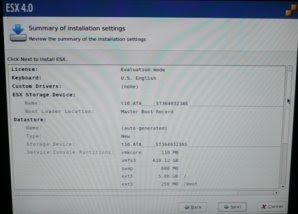
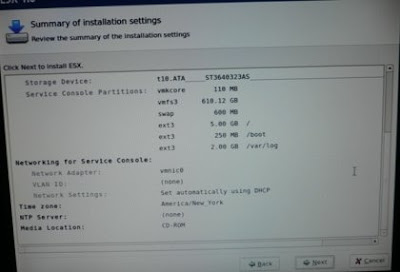
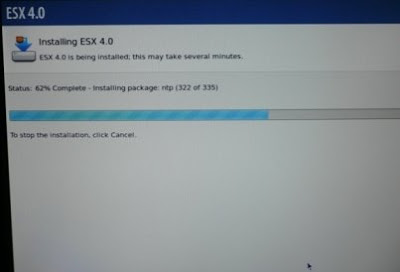
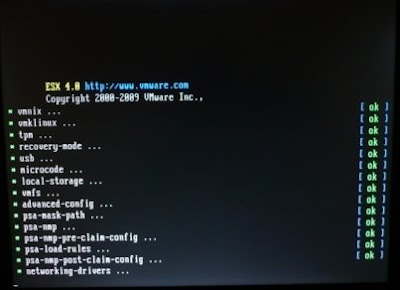
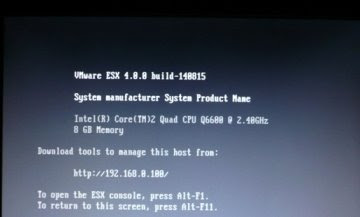
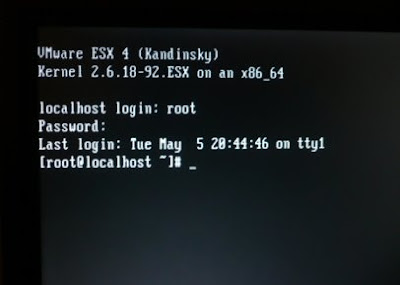
after an hour or so of putting the stuff together, I was able to finally start playing around with the ESX 4.0 bits.
I was relieved (and impressed) to find out that vSphere had no problems at all installing and running on my new whitebox:






My whitebox has the following specs:
CPU: Intel Core 2 Quad Q6600 Kentsfield 2.4GHz LGA 775
Board: ASUS P5BV-M LGA 775 Intel 3200 Micro ATX Intel
Drive: Seagate ST3640323AS 640GB 7200 RPM SATA
Memory: CORSAIR 4GB (2 x 2GB) 240-Pin DDR2 SDRAM DDR2
CD-ROM: ASUS 22X DVD Burner Black SATA Model DRW-22B1S
The installation was done from the SATA DVD - no issues at all.
All the on-board components (i.e. the dual NICs) were also detected no problem.
I am just getting going with this thing... Tomorrow I will install vCenter and a few VMs and after that will be testing upgrade scenarios from 3.5->4.0. Will post accordingly.
Friday, April 3, 2009
One App, One Windows - on VMware
I checked out VMware Workstation's Unity view mode about a month ago and I can't get by without it. Unity view allows any application in a Windows virtual machine running inside your VMware Workstation to appear "seamless" on your Windows desktop. Any application running inside your virtual machine appears exactly as if it was installed locally, the only thing to indicate it is a "Unity" app is a small VMware "boxes" logo next to the Minimize icon:



Unity also has its own Start Menu so that you can start new apps as needed within that virtual environment:

The reason I was drawn to Unity in the first place is ease of use when switching between local and virtual applications. And the reason why I had to use virtual apps is to be able to switch between different user identities as quickly and seamlessly as I could. The identities I was switching between were mainly my Google accounts - my personal account and my blogging account.
This leads me to the main topic of my post: One App One Windows - on VMware...
The reminder of my post may make you think I am ideologically opposed to Windows, which I can assure you I am not. What I am opposed to is Windows being the "OS". Let me explain.
Over the years, Windows operating system has grown well beyond the needs of users. Both in the case of desktops and servers. Users generally do not care about underlying functionality provided by the Windows OS. They care about applications. They care about being able to quickly start and shut down the computer, switch between applications, copy and paste, work with images. To them, Windows is a vehicle for running their applications. But Windows is not optimized to run applications. Windows is a general-purpose operating system trying to satisfy every user need, in effect not being "incredible" at any of its finite functions.
However, Windows is also the de facto only OS option out there (Apple Macintosh OS is really not different from Windows as far as the points I am driving in this post). This is GOOD. We are at this point in computing that we absolutely cannot afford even two different standards. We need one and Windows is great at providing that singular unified front upon which applications run.
But that is all Windows really ought to be: a reliable, rock-solid platform that knows how to run user applications well and fast. But Windows has been an Operating System, which needs to control many aspects, some of which are actually more critical than application performance - i.e. management of hardware and how the overall system performs. To illustrate how inefficient Windows is at it, follow my example: It is a well known fact that Windows slows down with time. For any of you who owns or works with Windows (who doesn't??) must have noticed this. When you get a new PC, the performance is great. After 1-2 months is becomes "almost" intolerable (I say Almost because people accept it as part of the deal - mostly unconsciously - and do not question it). After a month of regular daily usage key end-user performance measures drop like a stone: Starting and Shutting down Windows, starting apps, killing unresponsive apps (which tend to increase in number as time goes by), copying and pasting, working with graphics, to name a few.
Windows Servers suffer from the same fate (albeit to a lesser degree). It is not as noticeable because little end-user interaction with these systems takes place but believe me it is true. Server apps do slow down unrelated to other technical issues or problems - just because as the time goes on Windows becomes slower at handling tasks.
I do not postulate abandoning Windows - no, not at all. I think Windows has a great GUI, is very intuitive to use, and all the apps work on it. What I postulate is that Windows gives up control of what it does poorly: controlling the system and hardware, and instead focus on running the applications well all the time.
Let VMware hypervisor take care of the system management. Wouldn't it be great if I could refresh Windows on my laptop weekly - get that new car smell every Monday morning, that feeling of fast, reliable, rock-solid. It is difficult to do even for us geeks, and definitely an impossible feat for a typical user. However, with VMware it will soon be possible to do just that (via a client-side Type-I hypervisor they are working on - that in itself is a topic for an entirely new post though).
On the server side, it has been possible to do for years now and as a matter of fact many (thousands.. perhaps millions) data centers already utilize VMware ESX to shield (protect??) Windows from the hardware and system management tasks so it can focus on running apps.
Which brings me to the final key point of my post: Windows itself is an application that VMware hypervisor runs and manages best. Always fast, always reliable and fault-tolerant, always rock-solid. Exactly the way we want our beloved Windows to run but have never been able to. Each of these Windows applications is itself only permitted to run one "utility" application (end-user or server). Architected and deployed in this fashion, it truly becomes possible to have rock-solid performance from your Windows your Application, every time.
Just like with my Unity - I don't care about whatever else is on the virtual windows. All I care about is to have an isolated Gmail available to me to switch to instantly whenever I want to. And also to be able to dismiss it fast (err.. to hide my blogging addiction from a passing-by boss :-) by hitting that red square button.
Time will tell whether VMware is successful at wrestling the control of The System from Windows.
Subscribe to:
Comments (Atom)